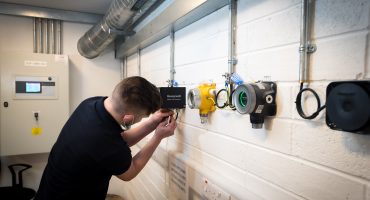Entering a confined space is often a necessary, but potentially hazardous task in various industries. Understanding the risks and preparing accordingly can significantly reduce the likelihood of accidents and injuries. This article will explore the critical aspects of safe confined space entry, drawing on established guidelines and industry best practices.
What is a Confined Space?
A confined space is an area not designed for continuous human occupancy, with limited openings for entry and exit. These spaces, such as tanks, silos, pits, and pipelines, often have poor natural ventilation, which can lead to hazardous atmospheres. Understanding what constitutes a confined space is crucial for implementing appropriate safety measures.
Confined spaces are defined by The Occupational Safety and Health Administration (OSHA) as spaces with one or more of the following characteristics a hazardous atmosphere, material that could engulf an entrant, walls that converge inwardly or floors that slope downward and taper into a smaller area which could trap or asphyxiate an entrant, or any other recognized serious safety or health hazards.
The Crucial First Step: Evaluation and Assessment
The confined space evaluation process is the critical step in ensuring worker safety. This involves a thorough assessment of the space to identify potential hazards, classify the space according to established safety standards (OSHA), and determine the necessary control measures to mitigate risks. Factors such as the space’s design, the tasks to be performed, and environmental conditions play a significant role in this evaluation.
Pre-Entry Preparations: Ensuring Safety from the Start
Before entry, several pre-entry requirements must be fulfilled. These typically include several critical steps, such as pre-entry assessment and permit, atmospheric testing, isolation of hazards, ventilation, communication and entry logs, personal protective equipment (PPE), emergency and rescue plans, as well as supervision and monitoring.
This procedure ensures that all potential risks are identified, assessed, and mitigated before and during entry into confined spaces, safeguarding the health and safety of workers.
Training: The Foundation of Safety
OSHA mandates specific training for all individuals involved in confined space entry. This training should cover hazard recognition, equipment use, emergency procedures, and specific duties of entrants, attendants, and supervisors. Ensuring that all team members are adequately trained is crucial for safe confined space operations.
Adhering to OSHA Standards
OSHA’s regulations (29 CFR 1910.146) provide a comprehensive framework for confined space safety. These standards require employers to assess their workplaces to determine if spaces are permit-required, develop a written permit space program if necessary, and ensure that employees are trained and follow specific procedures to safeguard their health and safety during confined space entry.
Air Quality and Atmospheric Testing
Air monitoring is a vital component of confined space safety, as hazardous atmospheres are a primary risk in these environments. Monitoring should be conducted before and during entry to detect toxic gases, flammable vapors, and oxygen deficiency or enrichment. Using appropriate air monitoring equipment is essential for making informed decisions about the safety of confined space entry.
Testing the atmosphere in a confined space involves a specific sequence to ensure safety. The usual order starts with testing for oxygen levels, followed by flammable gases and vapors, and then toxic substances. Each type of test requires specialized equipment and expertise to interpret the results accurately.
The Importance of a Confined Space Entry Kit
A well-prepared confined space entry kit is crucial for safe entry. It should include personal protective equipment (PPE) like respirators and harnesses, air monitoring devices, ventilation equipment, communication tools, emergency rescue gear, and entry permits. Each kit should be tailored to the specific hazards of the confined space being entered.
Additional Safety Considerations
Fire Prevention and Management
In spaces where flammable materials are present or hot work is performed, a designated fire watch person is essential in or near confined spaces. This individual is responsible for monitoring the area for signs of fire and is equipped to extinguish fires if they occur, ensuring the safety of all entrants.
Respiratory Protection
Depending on the confined space’s atmosphere, various types of respiratory protection may be required to protect workers from inhaling harmful gases, vapors, or particulates. Whether it is an air-purifying respirator or a self-contained breathing apparatus, depends on the specific contaminants present and their concentrations. Selecting the appropriate respiratory protection, based on the air quality assessment, is crucial for worker safety.
Lockout/Tagout Procedures
Lockout/tagout procedures are critical to ensure that all hazards within a confined space are secured before entry. These procedures protect workers from the unexpected activation of machinery or the release of hazardous energy, such as electrical, mechanical, and hydraulic, contributing to a safer work environment within the confined space.
Prioritizing Safety in Confined Spaces
Safe entry into confined spaces requires careful planning, thorough training, and strict adherence to safety protocols. By understanding the definitions, evaluating potential hazards, and implementing rigorous pre-entry requirements, employers can protect their workers from the risks associated with confined spaces. OSHA’s guidelines, along with proper air monitoring and the use of appropriate equipment, play pivotal roles in ensuring safety during confined space operations. As we continue to prioritize workplace safety, it’s crucial that these practices are not only followed but also regularly updated to reflect the latest in safety research and technology.
For those preparing to undertake confined space work, it’s essential to be equipped with the right knowledge and tools. Download our comprehensive Confined Space Entry Checklist to ensure you and your team are fully prepared to work safely and efficiently in these challenging environments.
By following these guidelines and using the provided resources, organizations can create a safer environment for their employees and reduce the risk of accidents and injuries in confined spaces. Safety is an ongoing commitment, and through continuous education, training, and vigilance, we can protect those who work in these challenging environments.
From the Blog



If you have any questions about our products or services, please feel free to contact us.

Join our mailing list to receive the latest news and updates from our team.